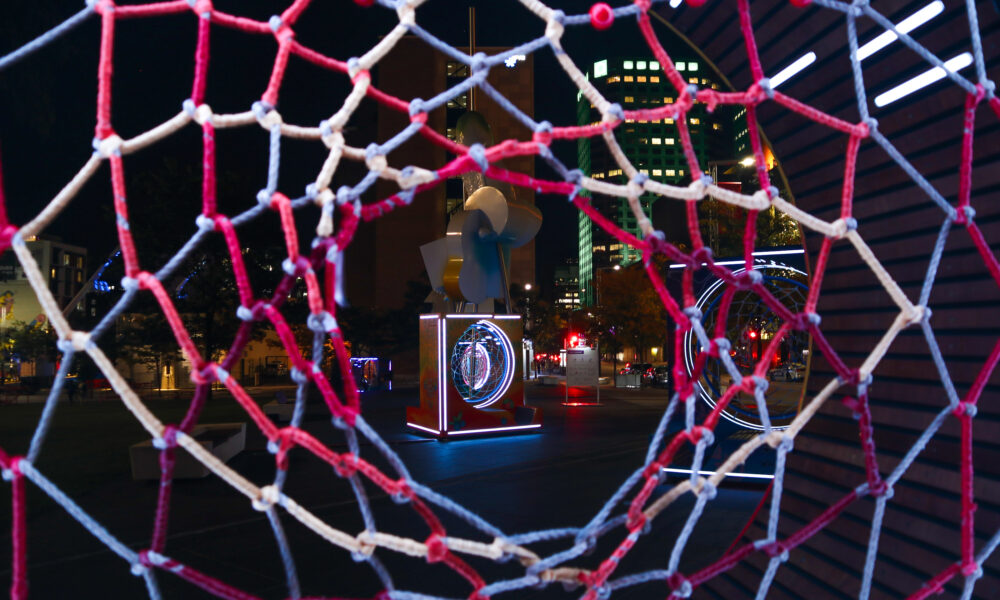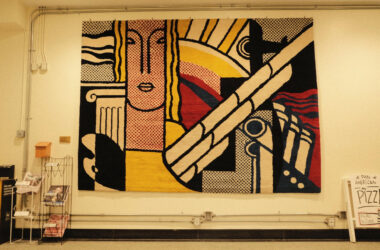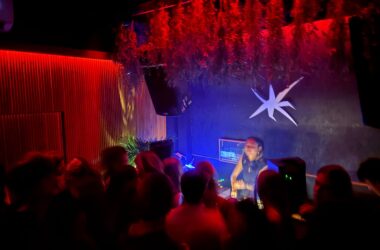What do you dream about? Hopes, fears, a pigeon wearing a coconut hat? What about your memories, or the pieces of yourself you can still hold on to? Weci | Koninut, a new installation in the Quartier des Spectacles, uses dreamlike experiences to ground audiences in the six seasons of Atikamekw culture, opening a doorway to the past and hopefully carrying its pieces into the future.
Created by Indigenous artists Julie-Christina Picher and Dave Jenniss, Weci | Koninut guides visitors through the six Atikamekw seasons, from Pitcipipon (pre-winter) to Takwakin (autumn). It specifically details the artists’ relationship with the Atikamekw people’s sacred land of Notcimik—how their ways of living and hunting there changed through the seasons.
Six colourful, boxy structures called ‘dreamcatchers’ facilitate the experience, each one separated through the middle by a woven mesh with space on either side to lie down. These dreamcatchers encourage visitors to come closer and activate the sounds, music, and spoken stories of the represented season. In one dreamcatcher, you hear footsteps crunch through the snow; in another, the excitement of the music seems to herald the coming of a more prosperous season.
These sounds, plus a spectacle of light that is projected down onto the audience member, do not give away too much. Even when there are spoken stories, you may not be able to understand them—that is the point.
“Weci | Koninut is, above all, a meeting point where our voices mingle with those of our ancestors,” explained Picher and Jenniss in a press statement.
“The dreamcatchers are thresholds that invite surrender to the rhythm of the Atikamekw seasons, guided by imagination and by the dialogue that unites us with the Earth.”
In creating a dialogue that concerns itself with both the present and past, the installation prompts our imagination to fill in some of the blanks for us.
The design of the dreamcatchers themselves helps create a connection among visitors. While separated from each other by the woven mesh of the dreamcatchers, participants still find even the most unintentional connection through a shared fascination with the structures or interest in how another reacts to their dream. Although nobody hears the same thing, the unspoken presence of another carries them into a reverie, expressing the idea that there’s always someone to help, to comfort, to brave the seasons.
These quiet connections with others echo the bond with the land that this installation conveys, where, as Picher and Jenniss mention in their statement, “each gesture and breath recalls the living bond with the land.” The land is presented as a living, breathing thing; it’s something that has to be worked through, something that presents obstacles, yet also joys and successes. This land emphasizes how these bonds of affection are the result of unity between people and the Earth.
In this project, every interaction between the audience and the art becomes part of the larger story. It’s where, despite being in the middle of the largest city in Quebec, a modern perspective can seamlessly drift into a lucid imagination about a culture that so valued—and still values—guardianship of the land.
With all this talk of dreaming and resonance with ancestors, it’s still important to remember that this art was not meant to memorialize a long-forgotten past. Weci | Koninut is, by its nature, echoing the lives and the callings of ancestors, but it also asks audiences to do more than just listen and move on. After all, dialogue means nothing if it does not bring change.
The act of dreaming and awakening to the same sounds, music, and voices of history juxtaposed against the backdrop of an overwhelming metropolis brings one closer to understanding contemporary Indigenous voices. Remember: These stories of culture are still living and breathing today as they have for generations. Just as dreaming is a sign of sleep, sleep is a sign of refreshment, and this installation refreshes our continued need for connection to nature and to those we’ve failed to listen to.









